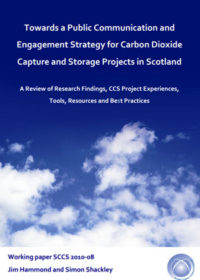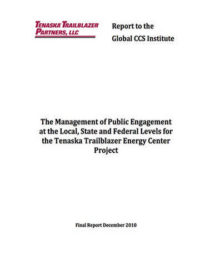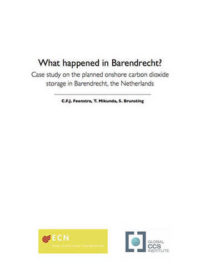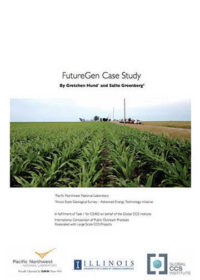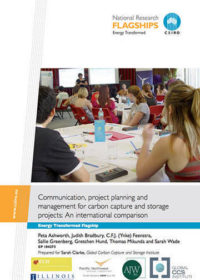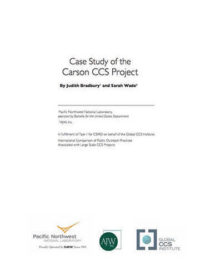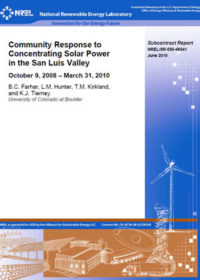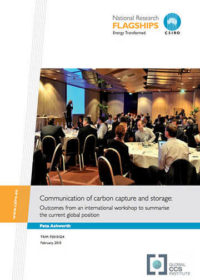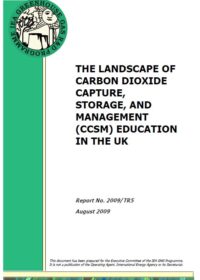Resources
Publications
Our publications, reports and research library hosts over 500 specialist reports and research papers on all topics associated with CCS.
View our Publication Library Disclaimer.
Filter by
Towards a public communication and engagement strategy for carbon dioxide capture and storage projects in Scotland: a review of research findings, CCS project experiences, tools, resources and best practices
6th December 2010
Topic(s): Carbon capture use and storage (CCUS), Communication, Public engagement
The purpose of this Scottish Carbon Capture & Storage report is to stimulate the design of effective engagement strategies between the public and proponents of CCS projects in Scotland. Engagement is the process of having an informed, two-way discussion as to whether a CCS project is appropriate in a particular locality and context. Successful engagement is not a guarantee that every project will go ahead. Projects may be rejected by publics even if they are technically viable, and establishing if this is the case early on would greatly speed the search for a suitable site. However if the reasons for a CCS project are sound, the plans carefully laid, and social conditions favourable, a good engagement strategy should greatly increase the chances of acceptance.
This report was authored by Jim Hammond and Simon Shackley. The work was funded under the Scottish Carbon Capture, Transport and Storage Development Study
Disclaimer
The content within the Global CCS Institute Publications, Reports and Research Library is provided for information purposes only. We make every effort and take reasonable care to keep the content of this section up-to-date and error-free. However, we make no claim as to its accuracy, currency or reliability.
Content and material featured within this section of our website includes reports and research published by third parties. The content and material may include opinions and recommendations of third parties that do not reflect those held by the Global CCS Institute.
The management of public engagement at the local, state and federal levels for the Tenaska Trailblazer Energy Center Project
1st December 2010
Topic(s): Carbon capture use and storage (CCUS), Public engagement
The Tenaska Trailblazer Energy Center (‘Trailblazer’ or ‘the Project’) is a cutting-edge coal-fueled electric generating plant currently under development just east of Sweetwater,Texas, United States of America (USA). It will be among the first such plants in the USA to include commercial-scale post-combustion carbon capture equipment in its initial design.
The Project will be among the cleanest coal-fueled power plants in the USA and will make a significant contribution toward efforts to curb carbon dioxide emissions. Over the past three years, the development team has made significant strides in educating the public and gaining support for this ground-breaking Project at the local, state and Federal level. This report discusses the steps Tenaska has taken to educate the public, inform them of the facts, and seek to gain support for the Project.
Disclaimer
The content within the Global CCS Institute Publications, Reports and Research Library is provided for information purposes only. We make every effort and take reasonable care to keep the content of this section up-to-date and error-free. However, we make no claim as to its accuracy, currency or reliability.
Content and material featured within this section of our website includes reports and research published by third parties. The content and material may include opinions and recommendations of third parties that do not reflect those held by the Global CCS Institute.
What happened in Barendrecht? Case study on the planned onshore carbon dioxide storage in Barendrecht, the Netherlands
3rd November 2010
Topic(s): Carbon capture use and storage (CCUS), Engineering and project delivery, Public engagement
This report is one of a series of case study reports undertaken by the CSIRO as part of an international comparison of communication and engagement practices surrounding carbon dioxide capture and storage (CCS) projects funded by the Global CCS Institute.
This case study describes events relating to the Barendrecht CCS project that took place between 2007 and 2010. The national and local context of the Barendrecht CCS project, technical aspects associated with the project, and associated stakeholder involvement are described. The report outlines defining moments that influenced relationships between stakeholders and their opinions of the project. It focuses on the characteristics of the communication that took place between stakeholders and with the community. Shortcomings in the communication are identified and presented as lessons for future CCS project developers.
Disclaimer
The content within the Global CCS Institute Publications, Reports and Research Library is provided for information purposes only. We make every effort and take reasonable care to keep the content of this section up-to-date and error-free. However, we make no claim as to its accuracy, currency or reliability.
Content and material featured within this section of our website includes reports and research published by third parties. The content and material may include opinions and recommendations of third parties that do not reflect those held by the Global CCS Institute.
FutureGen case study
2nd November 2010
Topic(s): Carbon capture use and storage (CCUS), Public engagement
This report is one of a series of case study reports undertaken by CSIRO as part of an international comparison of communication and engagement practices surrounding carbon dioxide capture and storage (CCS) projects funded by the Global CCS Institute.
This case study is a retrospective view of the United State’s FutureGen project, which was initiated in 2006. FutureGen was created as a partnership between the US Department of Energy (DOE) and the FutureGen Alliance (Alliance) – a non-profit consortium of around a dozen coal companies and electric utilities with operations around the world. This report details the Alliance’s effort and the Illinois FutureGen Team’s community engagement activities and the perceived effectiveness of this engagement. The timeline is from July 2006, when the four semi-finalist sites were selected, through December 2007, when Mattoon, Illinois was selected as the final site, and ends one year later.
Disclaimer
The content within the Global CCS Institute Publications, Reports and Research Library is provided for information purposes only. We make every effort and take reasonable care to keep the content of this section up-to-date and error-free. However, we make no claim as to its accuracy, currency or reliability.
Content and material featured within this section of our website includes reports and research published by third parties. The content and material may include opinions and recommendations of third parties that do not reflect those held by the Global CCS Institute.
Communication, project planning and management for carbon capture and storage projects: an international comparison
2nd November 2010
Topic(s): Carbon capture use and storage (CCUS), Public engagement
This report is an overview summary of a series of case study reports undertaken by the CSIRO as part of an international comparison of communication and engagement practices surrounding carbon dioxide capture and storage (CCS) projects funded by the Global CCS Institute.
This report provides an overview of the findings that have emerged from an international study comparing public communication and outreach practices associated with large scale carbon dioxide capture and storage (CCS) projects. The study focused on a direct comparison between five case studies of specific CCS projects and their associated communication and outreach activities. The five case studies were:
- Barendrecht Project – The Netherlands
- Carson Project – United States of America
- Future Gen Project – United States of America
- Zero Gen Project – Australia
- CO2CRC Otway Project – Australia
While there are key lessons around what constitutes best practice in communications and outreach, these alone are not sufficient to ensure successful CCS project deployment. The findings suggest that a project’s ability to adjust its planning and management to its social context is more likely to ensure a positive outcome for all involved in the project. A fundamental conclusion is that communication should not be seen as an add-on to the project. Successful projects integrate communication and outreach as a critical component of the project from the beginning.
Disclaimer
The content within the Global CCS Institute Publications, Reports and Research Library is provided for information purposes only. We make every effort and take reasonable care to keep the content of this section up-to-date and error-free. However, we make no claim as to its accuracy, currency or reliability.
Content and material featured within this section of our website includes reports and research published by third parties. The content and material may include opinions and recommendations of third parties that do not reflect those held by the Global CCS Institute.
Case study of the Carson CCS Project
12th October 2010
Topic(s): Carbon capture use and storage (CCUS), Communication, Public engagement
This report is one of a series of case study reports undertaken by CSIRO as part of an international comparison of communication and engagement practices surrounding carbon dioxide capture and storage (CCS) projects funded by the Global CCS Institute.
This case study examines the plan by BP to construct and operate a commercial hydrogen power plant with carbon capture and storage (CCS), in Carson, California. Carbon dioxide would be captured at the plant and piped to a location in nearby oilfields for enhanced oil recovery (EOR) that would result in carbon dioxide storage. The purpose of the study is to identify key lessons learned in communicating about future sequestration projects.
Disclaimer
The content within the Global CCS Institute Publications, Reports and Research Library is provided for information purposes only. We make every effort and take reasonable care to keep the content of this section up-to-date and error-free. However, we make no claim as to its accuracy, currency or reliability.
Content and material featured within this section of our website includes reports and research published by third parties. The content and material may include opinions and recommendations of third parties that do not reflect those held by the Global CCS Institute.
Community response to concentrating solar power in the San Luis Valley
1st June 2010
Topic(s): Public engagement, Renewables, Social research, Solar energy
This report is about the social acceptance of utility-scale renewable energy projects. In particular, it focuses on concentrating solar power (CSP) plants in the San Luis Valley (SLV or Valley), a large, sunny, high desert in south central Colorado, located within 200 miles of greater Denver. The research focused on social factors that may facilitate and impede the adoption and implementation of CSP—a technology that captures the sun's thermal energy using curved mirrors to focus sunlight onto a high temperature receiver.
Disclaimer
The content within the Global CCS Institute Publications, Reports and Research Library is provided for information purposes only. We make every effort and take reasonable care to keep the content of this section up-to-date and error-free. However, we make no claim as to its accuracy, currency or reliability.
Content and material featured within this section of our website includes reports and research published by third parties. The content and material may include opinions and recommendations of third parties that do not reflect those held by the Global CCS Institute.
Communication of carbon capture and storage: outcomes from an international workshop to summarise the current global position
1st February 2010
Topic(s): Carbon capture use and storage (CCUS), Communication, Public engagement
The inaugural conference was hosted by the Commonwealth Scientific and Industrial Research Organisation (CSIRO). In total, ninety-eight international representatives from industry, government, non-government organisations, researchers, and communication practitioners came together to participate in an interactive day specifically tailored to summarise the current global position on communicating for CCS deployment. The reports details the presentations made and makes some conclusions about future activities required.
The challenge of understanding public perceptions of CCS and how to communicate the risks and benefits of the technology is something that social researchers from leading international research institutions have been grappling with for some years. Up till now, the opportunity to share their findings with interested industry partners has been somewhat ad hoc as more technical issues have always taken priority. However, as the urgency to deploy CCS has risen across the world, and evidence of failed attempts to achieve local community support for projects comes to hand, it is apparent that this issuecould become a commercial show stopper for CCS. Therefore this opportunity to share findings from the research was well received from the range of stakeholders involved in CCS deployment.
Disclaimer
The content within the Global CCS Institute Publications, Reports and Research Library is provided for information purposes only. We make every effort and take reasonable care to keep the content of this section up-to-date and error-free. However, we make no claim as to its accuracy, currency or reliability.
Content and material featured within this section of our website includes reports and research published by third parties. The content and material may include opinions and recommendations of third parties that do not reflect those held by the Global CCS Institute.
The landscape of carbon dioxide capture, storage, and management (CCSM) education in the UK
1st August 2009
Topic(s): Carbon capture use and storage (CCUS), Education, Public engagement
The scope of this report is to identify academic perspectives and programs in the areas of CCS and carbon management currently available in the United Kingdom (UK). The information assembled in this report was sought from the internet, email contacts and visiting key universities in CCSM in the UK. This report addresses the major findings and discusses the current landscape of CCSM education in the UK.
Disclaimer
The content within the Global CCS Institute Publications, Reports and Research Library is provided for information purposes only. We make every effort and take reasonable care to keep the content of this section up-to-date and error-free. However, we make no claim as to its accuracy, currency or reliability.
Content and material featured within this section of our website includes reports and research published by third parties. The content and material may include opinions and recommendations of third parties that do not reflect those held by the Global CCS Institute.
